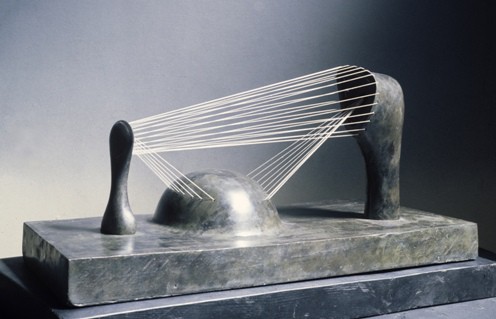
Stringed Relief, reproduced by permission of The Henry Moore Foundation
By James Dacey
My first experience of Henry Moore’s sculptures came from several visits to the Yorkshire Sculpture Park, located near where I grew up in the north of England. As a kid on a day trip with my parents, I was no art critic. But I was always fascinated by Moore’s looming bronze figures dotted across the rolling Yorkshire hillside. Within the works, I could see both the abstract body parts of a giant metal person, but also what appeared to be stark geometric shapes.
So, I was interested to hear the news that a new exhibition in London is celebrating Moore’s fascination with mathematics. The exhibition is being held jointly by the Royal Society and the Science Museum, and it showcases some of Moore’s lesser-known sculptures that were directly inspired by maths, including the work above, Stringed Relief. According to the exhibition catalogue, Moore (1898–1986) stated on several occasions that the use of string in his sculpture, which he started in 1937, was influenced by seeing models at the Science Museum in London.
I was fascinated by the mathematical models I saw there, which had been made to illustrate the difference of the form that is halfway between a square and a circle. One model had a square at one end with 20 holes along each side…Through these holes rings were threaded and lead to a circle with the same number of holes at the other end. A plane interposed through the middle shows the form that is halfway between a square and a circle…It wasn’t the scientific study of these models but the ability to look through the strings as with a bird cage and see one form within the other which excited me.
The exhibition, Intersections: Henry Moore and Stringed Surfaces, is open to the public now and it will run until 20 June.
Moore is by no means the only artist to have drawn inspiration from the ideas of science. One high-profile contemporary example is the British artist Anthony Gormley, who has created several sculptures inspired by the theory of quantum mechanics. It has also been suggested that Picasso’s development of the Cubist style of painting was informed by a similar line of thinking to Einstein’s during the formulation of the theory of relativity.



